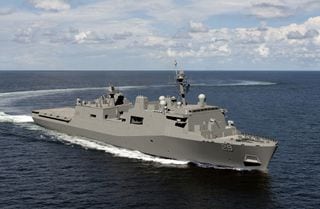Last week the Navy announced in a FedBizOpps posting that it selected Huntington Ingalls Industries’ [HII] Ingalls Shipbuilding to build the LX(R) amphibious transport dock replacement with Flight II San Antonio-class amphibious dock transport ships.
The notice intending to issue a sole source solicitation said HII “is the only source with the requisite knowledge and experience required to construct the lead ship” in the San Antonio-class Flight II.

The LX(R) program is a new class of amphibious ships set to replace 12 aging Whidbey Island/Harpers Ferry-class (LCD-41/49) amphibious ships. As noted in a Congressional Research Service (CRS) report to Congress, the Navy originally planned to procure 11 LX(R)s but that number may reach 13 following the newer force-level goal of 355 ships.
This will be a sole source detail design and construction (DD&C) contract for LX(R) amphibious transport dock ship and life cycle engineering and support (LCE&S). LPD-30 will be the lead ship in the class.
In February NAVSEA awarded HII a $1.4 billion DD&C award for LPD-29, the 13th LPD. The Navy expects LPD-29 to be delivered by 2023 (Defense Daily, Feb. 20).
Naval Sea Systems Command said the contract will include post-delivery availability planning, systems integration, and engineering support, design, material readiness, and logistics support for the San Antonio-class.
The notice said pursuing an alternative source for the LX(R) “would result in significant duplication of costs and unacceptable delays due to the loss of design expertise and production efficiencies achieved on the previous 13 ships that cannot be recovered on the first planned ship of Flight II.”
No other vendor possesses the needed facilities and expertise to design, plan, build, test, and deliver the future amphibious ships, the Navy said. General Dynamics [GD] NASSCO was also under consideration as a sole or possibly shared builder of LX(R).
A NAVSEA spokesperson said in an email notice was released for subcontracting purposes.
An Ingalls Shipbuilding spokesperson told Defense Daily in a statement that the Navy announcement “allows Ingalls to continue its strong legacy of building amphibious warships for the Navy. By utilizing the hot production line and strong vendor base established by the first 13 ships of the class, we will build LPD-30 and follow flight II ships at the best value and highest quality for the Navy.”
San Antonio-class ships embark and land Marines, their equipment, and supplies using air cushion or conventional landing craft, amphibious assault vehicles, helicopters, and other vertical takeoff and landing aircraft. Each ship can support a Marine Air Ground Task Force in various operations, help amphibious and expeditionary power projection missions, and provide humanitarian assistance.
HII has built and delivered 11 San Antonio-class LPDs, with the future USS Portland (LPD-27) the most recent one. It will be commissioned in Portland, Ore., on April 21. The USS John P. Murtha (LPD-26) is planned to deploy in 2019. LPD-28, the future USS Fort Lauderdale, is under construction with an expected launch date ointhe first quarter of 2020.
The LPDs are built at HII’s Pascagoula, Miss., shipyard.

Congress added LPD-28 and -29 to the production line as a bridge between LPD and LX(R) replacement ships. The LX(R) is expected to feature several new capabilities that will be incorporated on the LX(R) as an evolutionary advance. The newer ships feature updated weapons, mobile cranes on the flight and well decks, ramp modifications in the well deck, and somewhat smaller vehicle and cargo space to accommodate the well deck and ram (Defense Daily, Oct. 27, 2017).
Separately, NAVSEA’s PMS-317 office awarded Gibbs & Cox a contract for an undisclosed sum for engineering support services on LPD-17 and LX(R)-class ships. The company will provide program management for engineering support services, class engineering and technical support for both classes, and manage the PMS-217 engineering services design site.
“We are thrilled with this opportunity to provide technical services to PMS-317. Gibbs & Cox has supported the U.S. Navy for over 84 years, and we are honored to have been selected to join the PMS-317 organization,” Chris Deegan, president and CEO of Gibbs & Cox, said in a statement.
During the Navy League’s annual Sea Air Space Expo yesterday, the PEO Ships program manager for this program, Capt. Brian Metcalf, provided details about the upcoming LPD vessels.
USS Portland (LPD-27) will have its first deployment in 2020. The future USS Fort Lauderdale (LPD-28) is 18 percent complete as of March and is planned to launch in 2020 and be delivered in 2021. Finally, LPD-29 will have a keel laying in early 2019, then delivery is planned for 2023.
